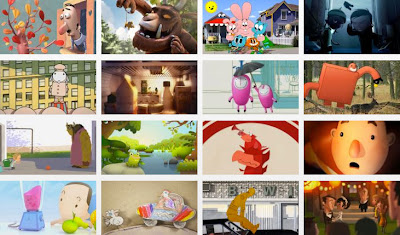Anyone that glanced at a TV over Christmas in 2009 is bound to have seen something of the animated adaptation of the Gruffalo. Although the voice talent consisted of an array of "Great British" actors it was in fact created in Ludwigsburg, Germany by the brilliant guys at Studio Soi. We were lucky enough to be invited to look around and were given an insight into their current projects and production technologies.
 |
| A selection of Studio Soi's impressive work. |
 |
| Image by Joseph Wallace |
Studio Soi was founded by seven students of the Film Academie Baden-Wurttemberg who wanted to continue to work together after graduation. They figured they would be able to set up their own studio in 2003 and are still going strong. The studio work in a wide range of mediums including CG, stop motion and traditional drawn animation. They also operate in Berlin with a design team situated in the capital for commercial business relations. Every morning at ten o clock the entire team from Ludwigsburg and Berlin meet via web chat to discuss their projects and progress.
Torbein Meier of Studio Soi gave us a quick tour, showing us their two spacious computer studios, kitchen and meeting/'presentation room, a very humble set-up boasting a real charm. We sat down for a showing of a few of their works including the Gruffalo, Ernst In the Autumn and The Little Boy And The Beast all incredible pieces showing a genuine love for the art of animation and storytelling.
 |
| Concept sketch for Little Boy and the Beast |
The studio are represented in Britain by Studio AKA, perhaps best known for their "Lloyds TSB" adverts, and have collaborated on many projects. Both studios have a distinctive art direction and a great eye for simplicity in design making their work really stand out. This is something I definitely aspire to adopt.
Torbein praised resident author Marcus Sauermann, the man responsible for many of their film's scripts. From what we had seen he has great talent and it goes to show how strong stories can drive great success.
Studio Soi's Ludwigsburg building is shared with a dozen other creative businesses provides access to warehouse space on the lower levels which when rented is available for live action, stop motion and office space when they require extra resources. It's a really economic system allowing production costs to be kept down. We ventured downstairs to see one of these spaces where the second Gruffalo was in production, "The Gruffalo's Child", and got a sneak peak at a few of the sets being dressed.
 |
| from storyboard to concept art to stop motion set. |
The Gruffalo is to date Studio Soi's most prominent work and has earnt them a great reputation within the Industry. The technical processes involved in it's creation are complex and require a physical set to be built for every scene in the film and then shot in stop motion. I found it hard to believe at first but all characters are computer generated and animated in 3D. When rendered a clever use of shaders and textures taken from real clay sculpts give the creatures a true visual continuity with the stop motion environment. The final film looks so tactile and hopefully the direction this film has taken will inspire many more similar features.
 |
| original illustration from "the Child of the Gruffalo" |
After Only a few hours we had all fallen in love with Studio Soi and their beautiful work but alas we had to go and leave them to work for the rest of the day. A great experience and deffinitely a studio I hope to work with in the future.










